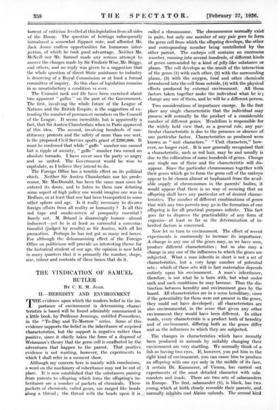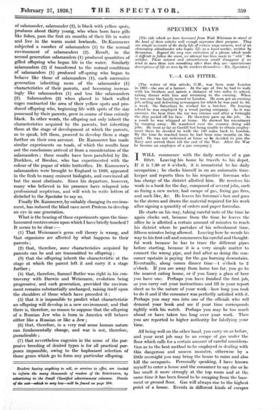THE VINDICATION OF SAMUEL BUTLER
BY C. E. M. JOAD.
. .
II.-HEREDITY AND ENVIRONMENT rTevidence upon which the modern belief in the im- iortance of environment in determining charac- teristics is based will be found admirably summarized in a little book, by Prigessor Jennings, entitled Prometheus, in the " To-Day and To-Morrow " series. Some of this ' evidence supports the belief in the inheritance of acquired haracteri ti but the t is negative rather tha cs cs, u e suppo s negan positive, since it chiefly takes the form of a disproof of Weismann's theory that the germ cell is unaffected by the adventures that happen to the parent. That positive evidence is not wanting, however, ' the experiments to which I shall refer in a moment show.
Although my concern here is mainly with conclusions, a word on the machinery of inheritance may not be out of place. It is now established that the substances passing from parents to offspring which form the offspring's in- heritance are a number of packets of chemicals. These packets of chemicals, called genes, are ranged like beads along a thread ; the thread with the beads upon it is called a chromosome. The chromosomes normally exist' in pairs, but only one member of any pair goes to form the germ cell from which the offspring develops, the other and corresponding member being contributed by the other parent. The embryo cell contains an enormous number, running into several hundreds, of different kinds of genes surrounded by a kind of jelly-like substance or. plasm. The cell develops as the result of the interaction of the genes (1) with each other, (2) with the surrounding plasm, (3) with the oxygen, food and other chemicals. introduced into the cell from outside, (4) with the physical effects produced by external environment. All these factors taken together make the individual what he is ; change any one of them, and he will be a different person.
Two considerations of importance emerge. In the first place any single characteristic that the individual may possess will normally be the product of a considerable number of different genes. Mendelism is responsible for the widely held view that, as a general rule, any par- ticular characteristic is due to the presence or absence a one particular factor. Characteristics so produced were known as " unit characters." " Unit characters," how- ever, no longer exist. It is now generally recognized that a characteristic, such as red hair, may be and usually is due to the collocation of some hundreds of genes. Change any single one of these and the characteristic will dis- appear. Since the particular chromosomes together with their genes which go to form the germ cell of the embryo ' appear to be chosen almost at haphazard from the avail- • able supply of chromosomes in the parents' bodies, it would appear that there is no way of securing that an offspring shall have any particular set of desired charac- teristics. The number of. different combinations of genes that with any two parents may go in the formation of one offspring is kir- all practical purposes infinite. This fact goes far to disprove the practicability of any form of eugenics—at least so far as the determination of in- herited factors is concerned.
Now let us turn to environment. The effect of recent experiments is enormously to increase its importance. A change in any one of the genes may, as we have seen, produce different characteristics ; but so also may a change in any one of the influences to which the genes are subjected. What a man inherits in short is not a set of characteristics, but a very large number of potential sets ; which of these sets will in fact materialize depends entirely upon his environment. A man's inheritance, therefore, is not what he is born with, but what under such and such conditions he may become. Thus the dis Unction between heredity and environment goes by the board. All characteristics are in a sense hereditary, since if the potentiality for them were not present in the genes, they could not have developed ; all characteristics are also environmental, in the sense that given any other environment they would have been different. In other words, every characteristic is a product both of heredity and of environment, differing both as the genes differ and as the influences to which they are subjected.
The changes in characteristics which have recently been produced in animals by suitably changing their environment are very startling. We normally think of a fish as having two eyes. If, however, you put him in the right kind of environment, you can cause him to produce an offspring with one eye only in the middle of its face. A certain -Dr. Kammerer, of Vienna, has carried out experiments of the most detailed character with sala- manders and toads. There are two sets of salamanders in Europe. The first, salamander (1), is black, has two . young, which at birth closely resemble their parents, and normally_ inhabits cool Alpine uplands. The second kind of salamander, salamander (2), is black with yellow spots, produces about thirty young, who when born have gills like fishes, pass the first six months of their life in water and live in the warm moist lowlands.. Dr.Kammerer subjected a number of salamanders (1) to the normal environment of salamanders (2). Result, in the second generation salamanders (1) produced quantities of gilled offspring who began life in the water. Similarly salamanders (2) if transferred to the normal conditions of salamanders (1) produced off-spring who began to behave like those of salamanders (1), each successive generation inheriting more of the salamander (1) characteristics of their parents, and becoming increas- ingly- like salamanders (1) and less like salamanders (2). Salamanders (2) when placed in black walled cages contracted the area of their yellow spots and pro- duced offspring who, beginning life with spots of the size possessed by their parents, grew in course of time entirely black. In other words, the offspring not only inherit the characteristics acquired by the parents,' but inheriting them at the stage of development at which the parents, so to speak, left them, proceed to develop them a stage further on their own account. Dr. Kammerer has made similar experiments on toads, of which the results bear out the conclusions arrived at from a consideration of the salamanders ; these results have been paralleled by Dr. Durkhen, of Breslau, who has experimented with the colour of the pupae of white butterflies. Dr. Kammerer's salamanders were brought to England in 1923, appeared in the flesh to many eminent biologists, and convinced all but the most obstinate. Since his departure, however, -many who believed in his presence have relapsed into professional scepticism, and will wish to write letters of disbelief to the Spectator to say so.
Finally Dr. Kammerer, by suitably changing its environ- ment, has induced the blind cave newt Proteus to develop an eye in one generation.
What is the bearing of these experiments upon the time- honoured controversies upon which I have briefly touched ? It seems to be clear :— • (1) That Weismann's germ cell theory is wrong, and that organisms are affected by what happens to their parents ; (2) that, therefore, some characteristics acquired by parents can be and are transmitted to offspring ; -(3) that the offspring inherit the -characteristic at the stage at which the parent left it and carry it a stage further ; (4) that, therefore, Samuel Butler was right in his con- - troversy with Darwin and Weismann, evolution being progressive, and each generation, •provided the environ- s went remains substantially- unchanged, raising itself upon the shoulders of those which have preceded it ; (5) that it is impossible to predict what characteristic an -offspring will develop in a new environment, and that there is, therefore, no reason to suppose that the offspring of a Russian Jew who is born in America will behave either like a Russian or like a Jew ; (6) that, therefore, in a very real sense human nature can fundamentally change, and war is not, therefore, ineradicable ; (7) that nevertheless eugenics in the sense of the pur- posive breeding of desired types is for all practical pur- poses impossible, owing to the haphazard selection of those genes which go to form any particular offspring.























































 Previous page
Previous page